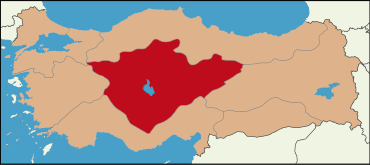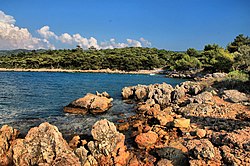The geographical regions of Turkey comprise seven regions (Turkish: bölge), which were originally defined at the country's First Geography Congress in 1941.[1] The regions are subdivided into 31 sections (Turkish: bölüm), which are further divided into numerous areas (Turkish: yöre), as defined by microclimates and bounded by local geographic formations.
| Regions of Turkey Türkiye'nin bölgeleri (Turkish) | |
|---|---|
 | |
| Category | Unitary state |
| Location | Turkish Republic |
| Number | 7 |
| Populations | 6,513,106 (Eastern Anatolia) – 26,650,405 (Marmara) |
| Areas | 59,176 km2 (22,848 sq mi) (Southeastern Anatolia Region) – 165,436 km2 (63,875 sq mi) (Eastern Anatolia Region) |
| Government |
|
| Subdivisions |
|

List of geographical regions
- Marmara Region (dark green)
- Black Sea Region (light green)
- Aegean Region (blue)
- Mediterranean Region (purple)
- Central Anatolia Region (brown)
- Eastern Anatolia Region (orange)
- Southeastern Anatolia Region (yellow)
"Regions" as defined in this context are merely for geographic, demographic, and economic purposes and do not refer to an administrative division.
Regions and subregions
| Region | Largest city | Area (km2) | Provinces (Counties) | Population (2021) | Location |
|---|---|---|---|---|---|
| Aegean Region | İzmir | 85,000 | 8 | 10,477,153 |  |
| Black Sea Region | Samsun | 143,537 | 18 | 7,696,132 |  |
| Central Anatolia Region | Ankara | 163,057 | 13 | 12,896,255 |  |
| Eastern Anatolia Region | Van | 165,436 | 14 | 6,513,106 |  |
| Marmara Region | Istanbul | 67,000 | 11 | 26,650,405 |  |
| Mediterranean Region | Antalya | 122,927 | 8 | 10,584,506 |  |
| Southeastern Anatolia Region | Şanlıurfa | 59,176 | 9 | 8,576,391 |  |

- Aegean Region
- Aegean Section
- Edremit Area
- Bakirçay Area
- Gediz Area
- İzmir Area
- Küçük Menderes Area
- Büyük Menderes Area
- Mentese Area
- Inner Western Anatolia Section
- Aegean Section

- Black Sea Region
- Western Black Sea Section
- Inner Black Sea Area
- Küre Mountains Area
- Central Black Sea Section
- Canik Mountains Area
- Inner Central Black Sea Area
- Eastern Black Sea Section
- Eastern Black Sea Coast Area
- Upper Kelkit - Çoruh Gully
- Western Black Sea Section

- Central Anatolia Region


- Marmara Region

- Mediterranean Region
- Adana Section
- Çukurova - Taurus Mountains Area
- Antakya - Kahramanmaras Area
- Antalya Section
- Adana Section

- Southeastern Anatolia Region
Distinctions of the regions
The Aegean Region has:
- the longest coastline

The Black Sea Region has:
- highest annual precipitation
- largest forest area
- fewest sunshine hours
- most landslides

The Central Anatolia Region has:
- lowest annual precipitation,
- most erosion
The Eastern Anatolia Region has:
- largest area
- highest elevation
- lowest annual temperature
- coldest winters
- highest temperature difference between seasons
- most volcanic activity
- smallest population
- highest[vague] mineral resources

The Marmara Region has:
- smallest area
- lowest elevation[dubious ]
- most climate diversity
- highest energy consumption,
- coolest summers,
- largest population

The Mediterranean Region has:
- highest annual temperature
- mildest winters
- wettest winters,
- most greenhouse farming
The Southeastern Anatolia Region has:
- hottest summers
- driest summers
- smallest forest area
- most sunshine hours
Population by region
| Region | Population |
|---|---|
| Marmara | 26,650,405 |
| Central Anatolia | 12,896,255 |
| Mediterranean | 10,584,506 |
| Aegean | 10,477,153 |
| Southeastern Anatolia | 8,576,391 |
| Black Sea | 7,696,132 |
| Eastern Anatolia | 6,513,106 |
See also
References
🔥 Top keywords: Main PageSpecial:SearchIndian Premier LeagueWikipedia:Featured picturesPornhubUEFA Champions League2024 Indian Premier LeagueFallout (American TV series)Jontay PorterXXXTentacionAmar Singh ChamkilaFallout (series)Cloud seedingReal Madrid CFCleopatraRama NavamiRichard GaddDeaths in 2024Civil War (film)Shōgun (2024 miniseries)2024 Indian general electionJennifer PanO. J. SimpsonElla PurnellBaby ReindeerCaitlin ClarkLaverne CoxXXX (film series)Facebook2023–24 UEFA Champions LeagueYouTubeCandidates Tournament 2024InstagramList of European Cup and UEFA Champions League finalsJude BellinghamMichael Porter Jr.Andriy LuninCarlo AncelottiBade Miyan Chote Miyan (2024 film)